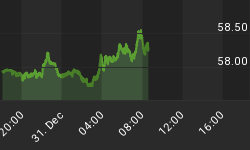
- China's major policy shift
- Concerns are not showstoppers
- Tech bubble case not convincing
- Fractals lean bullish
- Fed providing liquidity
Policy Shift Turns Laggard Into Leader
Healthy and sustainable bull markets tend to lift all equity boats around the globe. As shown in the chart of the China ETF below (FXI), Chinese stocks struggled for the first six months of 2013. Last week's major announcement from Chinese leaders helped FXI push to a new five month high. From Reuters:
Investors rewarded Beijing on Monday for its ambitious reform plan, sustaining a stocks rally led by consumer goods shares seen as direct beneficiaries of the promised easing of China's one-child policy and efforts to boost consumption. Key onshore China stock indexes rose the most in more than two months, while China shares listed in Hong Kong were heading for their biggest daily percentage gains in almost two years in high volume trade.

Myth Busters: Yeah, But Shouldn't We Be Concerned About...?
As stocks advanced off the October 9 low, the "reasons" to remain on the sideline have included "rallies not led by financials are unsustainable" and "Dr. Copper is waving red flags". This week's stock market outlook video contains a myth busters section, which provides hard evidence that some concerns are not necessarily rally killers.
The Bubble Case Is Not Convincing
As we outlined in detail and supported with facts on November 12, the case that "we are in a bubble and everyone is in this market" does not hold water. If we focus on the NASDAQ, the differences are significant between the 2013 rally in technology stocks and the 1999 bubble rally. From The Wall Street Journal:
The tech-heavy index is poised to cross 4000 for the first time in 13 years, a development that has stoked concerns another tech-bubble is forming. But the Nasdaq nowadays has more dividend payers, fewer dot-coms and a more reasonable valuation, a nod to the evolution of an index once only known for tech and growth stocks. Currently, 51 of the top 100 Nasdaq stocks pay dividends. In December 1999, when the Nasdaq initially jumped above 4000, only nine companies paid dividends, according to stock-market research firm Birinyi Associates. The Nasdaq now trades at about 25 times the previous year's earnings, compared with 151 times trailing earnings in December 1999. Beyond dividends, there are other characteristics that show the differences between then and now. In 1999, there were 119 companies in the Nasdaq that had ".com" in their name. Now, there are 15. In 1999, stocks were in a bubble. Now, the evidence isn't as convincing

Breakouts Are Bullish, Right?
Charts allow us to monitor the battle between aggregate economic optimism and aggregate economic concerns. When optimistic investors have greater conviction than pessimistic members of the global crowd, stock prices go up. During periods of indecision, where there is no clear winner on the conviction front, stocks tend to consolidate or go sideways. A bullish breakout occurs when bullish economic conviction finally overpowers bearish economic conviction. The concepts of a base, described below, apply to individual stocks, ETFs, or major stock indexes. From Investor's Business Daily:
Before a stock can launch a big price run up, it must have a solid base pattern to build upon.
It's sort of like the foundation for a house: if it's not solid, the levels above can become unstable. For stocks, base patterns serve as that foundation. They occur when a stock's price falls and consolidates over a series of weeks, months, or years.

If you have experience in the financial markets, it is difficult to make the case that the chart above leans any way, other than bullish. The term "leans" speaks to probabilities. This video clip, using a widely accepted concept of market fractals, explains periods of investor indecision (a base) in the present day and then applies the concept to the longer-term (last 13 years).
Fed Keeps Liquidity Flowing
On November 15, we argued the Fed will most likely continue printing money longer than most market participants believe. Janet Yellen, while testifying before Congress last week, gave investors little reason to believe she intends to terminate the Fed's bond buying program anytime soon. From Bloomberg:
"I don't see evidence at this point, in major sectors of asset prices, misalignments," she said yesterday during her confirmation hearing to be the next Fed chairman. "Although there is limited evidence of reach for yield, we don't see a broad buildup in leverage, where the development of risks that I think at this stage poses a risk to financial stability." Yellen signaled her determination to use bond buying to strengthen the economy and drive down the nation's 7.3 percent unemployment rate. Testifying to the Senate Banking Committee as benchmark U.S. stock indexes rose to records, she sought to dispel concerns from senators that the central bank's policy is pumping up the values of equities and housing to such an extent that it jeopardizes market stability.
Investment Implications
Our market model began redeploying cash on October 10, based on improvement in the market's risk-reward profile. As long as the observable evidence supports a risk-on stance, we will continue to hold positions in the United States (SPY), Europe (FEZ), and emerging markets (FXI). The wild card is Fed policy. If economic data comes in better than expected, the Fed could rekindle tapering fears similar to those that surfaced in late May. Flexibility remains a key tenet of investment success, which acknowledges things can change fast in the world of investing.
















